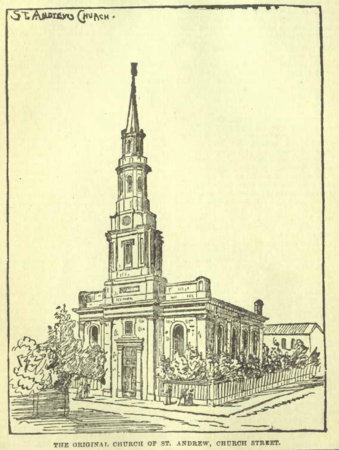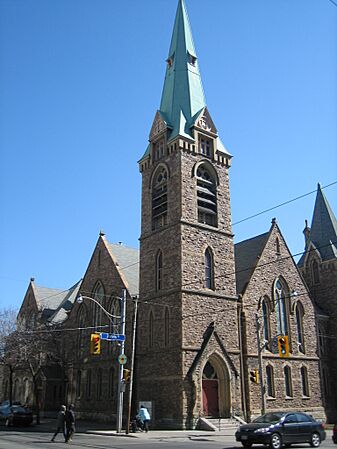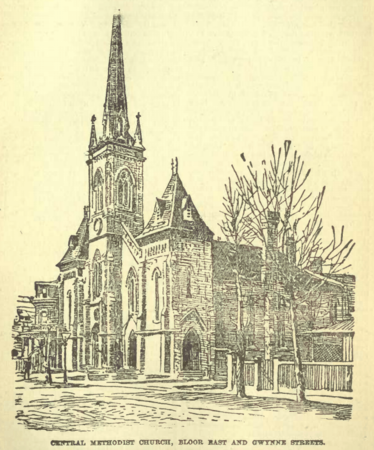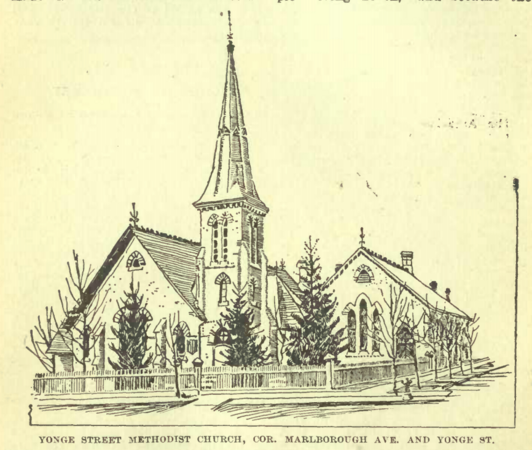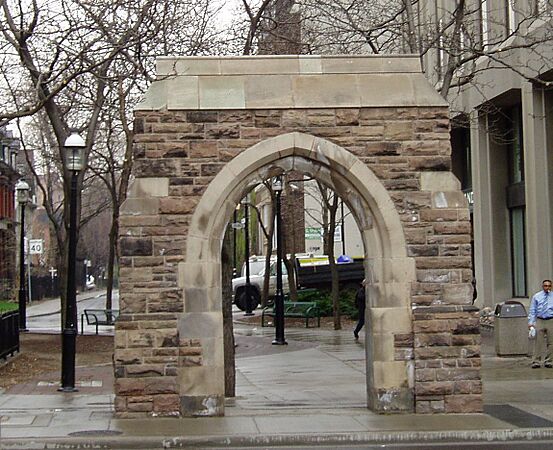St. Andrew's United Church facts for kids
Quick facts for kids St. Andrew's United Church |
|
|---|---|
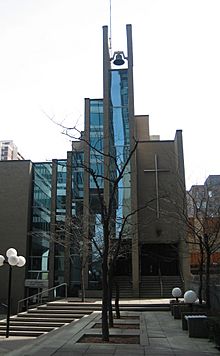
View of the church building in 2009
|
|
| Location | 117 Bloor Street East Toronto, Ontario M4W 1A9 |
| Country | Canada |
| Denomination | United Church of Canada |
| Previous denomination | Church of Scotland |
St. Andrew's United Church is a historic church in Toronto, Canada. It is located in the city's downtown area. This church is special because it combines five other church groups from downtown Toronto. It is part of the United Church of Canada.
Contents
History of St. Andrew's
How the Church Started
St. Andrew's Church began in 1830. It was the first Church of Scotland group in what was then called York. York is now the city of Toronto. The first St. Andrew's church building was located at Adelaide and Church Streets.
A Church Divides
By the 1870s, the church needed a new building. Most of the church members wanted to move to a new location further west in the city. However, a smaller group wanted to stay in the same area. Because of this, the church split into two groups.
In 1876, the larger group moved to a new building. This building is still used today as St. Andrew's Church at King and Simcoe streets. The smaller group stayed in the eastern part of town. They became known as "Old St. Andrew's."
Joining the United Church
In 1878, the "Old St. Andrew's" group built a new church. This building was at the corner of Jarvis and Carlton streets. In 1925, the United Church of Canada was formed. Old St. Andrew's decided to join this new church union. The St. Andrew's Church on King Street chose to remain Presbyterian.
Many Churches Become One
Over the years, fewer people attended United Churches in downtown Toronto. Because of this, several church groups joined together. Today, St. Andrew's United Church is the result of four other churches merging.
In 1950, Westminster-Central United Church joined with St. Andrew's. The combined church kept the name St. Andrew's. However, the group left the Jarvis Street building. They moved to the Westminster-Central location on Bloor Street, near Yonge Street. The old Jarvis Street building was sold to two Lutheran church groups. These groups were growing quickly in Toronto. They kept the name St. Andrew's and became St. Andrew's Evangelical Lutheran Church.
The Westminster-Central Story
Westminster-Central United Church was also a combination of three older Toronto churches. Westminster Presbyterian Church was the first church built at the Bloor Street site in 1891. In 1921, it merged with Grosvenor Street Presbyterian. Grosvenor Street's building was taken down to make way for the extension of Bay Street.
When the United Church was formed in 1925, Westminster Presbyterian merged again. This time, it joined with Central Methodist Church, which was located across the street. This merger created Westminster-Central United Church.
The Final Merger
The last church to join St. Andrew's was Yonge Street United Church in 1973. Yonge Street United Church was originally located at Yonge and Summerhill. Its building was destroyed by fire in May 1971.
A New Building for a New Era
The Westminster building, which became home to St. Andrew's after 1950, was built in 1923. The original 1891 building had been destroyed by fire in 1920. In the mid-1970s, the church faced a big decision. It needed money, but its land was very valuable.
After much discussion, the church decided to take down the old building. They built an office tower above the church space. The church itself moved to the lower levels of this new complex. The new building was finished in 1981.
The current St. Andrew's Church is at 117 Bloor Street East. It is a separate building that faces Bloor Street. It is set back into a courtyard called St. Andrew's Square. It sits next to the office tower at 121 Bloor Street East. Part of the old church building was saved by the city of Toronto. It is now located further south on Yonge Street. It marks the entrance to McGill Street. Other United Churches, like College Street United Church and Parkdale United Church, also chose to redevelop their properties in a similar way.
Past buildings
Here are some of the past buildings that housed St. Andrew's and the other churches that merged to create it:
See also
- List of United Church of Canada churches in Toronto


